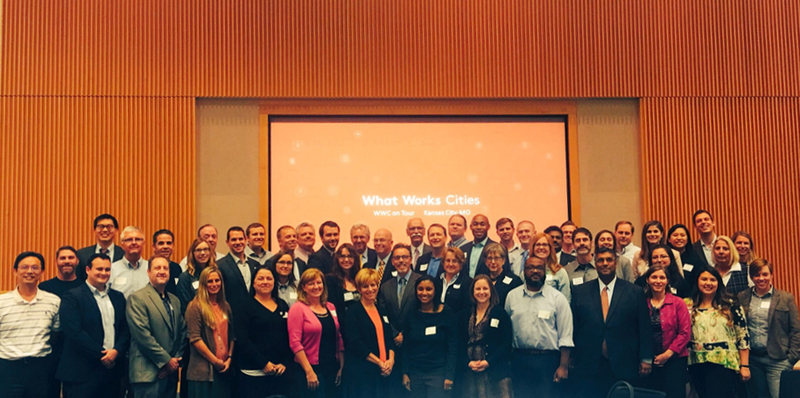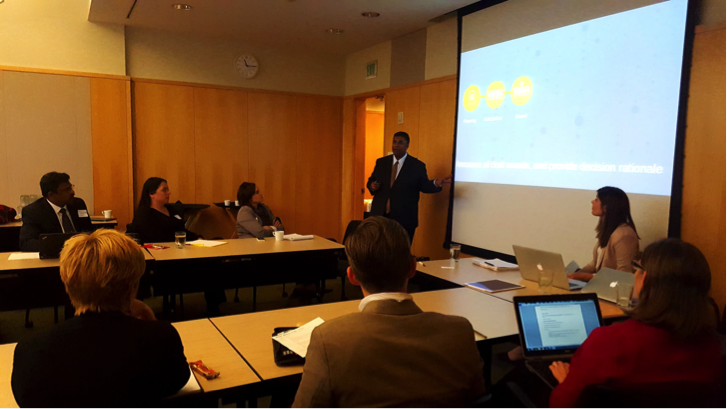The OCP and Sunlight take open contracting on tour with What Works Cities

The What Works Cities partnership made a pit stop – barbeque included – in Kansas City, Mo., last week to take the program on tour. Sunlight Foundation and the Open Contracting Partnership (OCP) teamed up to present our updated procurement open data guidelines. This is part of a new approach Sunlight is hoping to take in our scope of technical service provision with What Works cities across the country.
Sunlight initially launched an open procurement initiative in 2013. We surveyed over two dozen U.S. city and county governments to gain insights into municipal procurement trends, best practices and areas for improvement across the process.
This summer, we decided to pick up our open procurement work to support our WWC technical assistance delivery. We’re currently working with the OCP to update our Procurement Open Data Guidelines, eventually becoming our new Municipal Open Contracting Guidelines. Yesterday, we had the opportunity to share this work with our city partners at the What Works Cities on Tour event in Kansas City.
The procurement workshop
Sunlight and the OCP held two workshops presenting our research to 53 staff from 13 cities across the country. We explained the role of open data in making procurement more accountable and competitive. We also discussed resources that can enable a shift to open up procurement data, such as the Open Contracting Data Standard which facilitates data disclosure across the full procurement cycle. After presenting our findings, we asked the city staff to break into small groups and identify some presumed benefits and barriers to opening up contracting data. We then came back together and reported out, giving an opportunity for some brand new open contracting champions to convince the skeptics.
Here’s what we learned from our city partners:
- Importance of promoting and contextualizing data: When you put out data without a plan for outreach, you miss an opportunity both to ensure that the data is being used for the purposes you’ve defined and to tell your own story about the data. At various stages of the process, efforts should be made to educate the public about the data through public communication and meaningful engagement. Along these lines, some workshop participants were concerned that data might be manipulated to tell a story that may not necessarily be true. To prevent this, cities must release data with appropriate technical solutions and tell a complete and accurate narrative.
- Importance of strategy and iteration: As you would with any open data, you should be strategic about where you start. Instead resorting to a data dump, cities talked through the importance of prioritizing data to be released. Clear methods for prioritizing data to be released should be decided on early. Some participants did point out that being selective in which data to release does not result in full transparency. However, it’s important to keep you mind that you have to start somewhere. It’s also important to collect as much feedback as possible along the way to inform your future approach to data release, integrating any necessary changes to the process.
- Opening contracting data can help inform procurement policy: Opening contracting data allows for more eyes on the data – and better analysis – which leads to greater feedback on the existing processes that will help inform the direction of procurement in cities. Cities were excited about the option to use data collected for sharing with the public, evaluating contractors, identifying spending trends, and strategically planning future projects. While the public and other stakeholders benefit from access to open data, some of the greatest gains come to government staff themselves, from the process of developing and publishing data, and from access to data published by other departments and agencies.
- Learning and sharing: The more contracting data becomes open, the more best practices can be identified and replicated in cities around the country. Participants were excited at the potential to learn from their peers about how opening contracting data can be best accomplished. Some cities already engage in programs to help improve procurement processes, such as educational courses for contract administrators. These lessons will certainly be shared across the What Works Cities peer network and beyond, making it easier for new cities to get started with the process. Further, because we are relatively early on in the open data movement, cities cannot yet give precise examples of return on investment for opening data. Cities can, however, use open data to learn from their peers about approaches that have led to positive procurement outcomes.
- Breaking down silos: One message that came up consistently was the way that open contracting data could enable professionals within government to better share information, coordinate, manage funds and track the taxpayer dollar. Opening up the process can distribute the risk of having just one person or office in charge of making procurement decisions.
- Time saved vs. time spent: When more information is available throughout various stages of the process, it becomes easier to identify problem areas in work being completed and make quickly adapt the processes as needed. This can prevent small issues from becoming larger problems, ultimately saving time that might be spent correcting errors further down the line. Additionally, finding ways to automate updates or milestones through the stages of a contract, perhaps even asking contractors themselves to be involved in the process, can help save staff time and resource.
- Users drive use! This was an overarching theme that emerged related to engaging users and understanding their needs. Taking the process of user needs identification seriously has critical implications for not only what data is prioritized for disclosure, but also in how that information is presented. The complexity of municipal contracting, as well as the possible benefits of opening data related to it, mean that the information needs to be simple to understand and interact with. For inspiration, we explored some great examples in Topeka, Los Angeles, New York and even Mexico City.

The benefits and barriers to opening municipal contracting data make for a challenging journey. But to begin the process, we offer a crucial piece of advice: Determine and stick to clear policy objectives for your open procurement program and continue to draw upon these throughout the process.
Each dataset has an audience, each newly transparent stage of the procurement process bears fruit. With each success, the next challenge becomes easier, some skeptics are convinced and the resources to move forward are easier to secure! Opening procurement data is a process that builds on itself, so it’s alright to start with the most acute needs and grow from there.
We look forward to continuing our research on best practices to help inform our work with What Works Cities and beyond.

